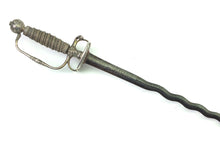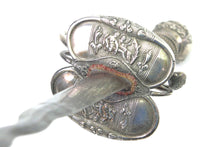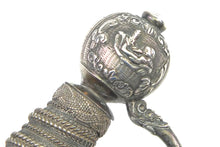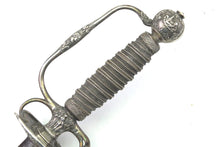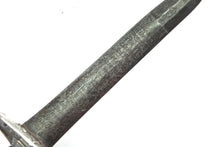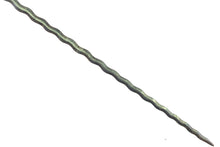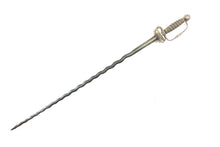
A Rare English Silver Hilted Small Sword.
Missed out on this item? Click to view all current Antique Swords & Edged Weapons Free UK delivery on all items.
36” overall, 29” tapering waved blade of flattened hexagonal section, the forte on both sides etched in Latin with proverbs, one side surmounted by crossed swords & the labelled figures of 'St. Carolus' & coat of arms of the Barons Barry, the other side surmounted by crossed palms & the figure of 'St. Agnes' & a crowned coat of arms, the etching retaining traces of gilding. Silver hilt cast & chased in low relief with Classical figures in landscapes against finely stippled grounds on both sides of the double shell guard, quillon block & globular pommel, plain arms, lobed rear quillon with a floret on each side, knuckle guard with a portrait bust of a Roman emperor between florets on each side, the terminal formed as a monster, its tail hooked into the pommel. Wooden grip bound with three thicknesses of silver wire between Turks' heads.
Mid 17th Century, unidentified London Silver Maker's mark ‘R’ stamped on the knucklebow, pommel and shell guard.
Rare sword in very good condition, wavy blades are very uncommon as small swords.
The coat of arms may refer to the barony of the Barry family which became extinct in 1751 on the death of the notorious 4th baron Henry Barry (1710-1751), a member of the Dublin Hellfire club, whose conviction for murder resulted in a pardon from King George II Sold with some research.
For related examples see Leslie Southwick, ‘London Silver-hilted Swords’..., 2001, p. 277, pls. 20 & 21.
Barry, Henry (1710-51), 4th Baron Barry of Santry. Only child of Henry Barry (1680-1735), 3rd Baron Barry of Santry, and his wife Bridget, elder daughter of Sir Thomas Domvile, 1st bt., born 3 September 1710. He was evidently a 'typical 18th century rake', a heavy drinker, a leading member of the Irish Hellfire Club, & possessed of a quarrelsome and violent nature: Dean Swift had chided his mother about his early misdeeds. On the evening of 9 August 1738, when he had been drinking heavily all day with friends in the kitchen of a tavern at Palmerstown near Dublin, he got into an argument with a Mr Humphries, but was so befuddled with drink that he found himself unable to draw his sword. He flew into a rage and stormed from the room, but collided with the tavern porter, Loughlin Murphy, before reaching the street. He shoved Murphy (who according to some accounts had formerly been his running footman, & had been invited to join the drinking party earlier in the day) back into the kitchen, and swore that he would run through the next man who spoke. 'With startlingly ill-judged courtesy, Murphy wished that no one would offend the noble lord', whereupon, true to his word, Lord Santry plunged his sword into Murphy's side. Murphy was not killed outright but died - probably from an infection in his wound - some weeks later in Dublin. Lord Santry was then arrested and charged with murder, but claimed the privilege of a trial by his peers in the Irish House of Lords. The trial was held on 27 April 1739, and such was the brilliant oratory of the prosecution and the weakness of the defence, that there was a speedy conviction and, since murder was treated as high treason in Ireland, an automatic sentence of death. As a convicted felon, Lord Santry's title and estates were also forfeited to the Crown, but after the trial, Lord Santry's friends and relatives appealed to King George II to exercise his prerogative of mercy and grant a pardon or at least a reprieve. Those making representations for mercy included all but one of the peers who had been on the jury convicting him. The king was initially reluctant to grant clemency, but was eventually persuaded, and a pardon was finally issued (Although not before a new axe had been purchased for the planned execution: it is reputed to have been acquired and preserved by the Domvile family as an heirloom ) on 17 June 1739, although his title was forfeited for life, and he felt obliged to leave Ireland, living the rest of his life in exile in England. Alongside the trial, Lord Santry was being pressed by his creditors for debts of some £13,000, and after his property was restored to him in 1741, his uncle secured an Act of Parliament vesting his property in trustees for the payment of his debts. By 1744, however, the trustees had ceased to act and his agent was managing his affairs in Ireland. In exile he lived in modest comfort, supported in part by the payment by the Treasury of pension arrears due to his father, for which an inexplicable allowance of £50 a month was eventually substituted. History does not record that anything was done, either by the family or the government, to support the family of the murdered tavern porter. In his last years he suffered increasingly from gout and depression. He married 1st, 8 May 1737 at Finglas (Co. Dublin), Anne (d. 1742), daughter of William Thornton of Finglas (Co. Dublin) and 2nd, 7 November 1750 at Ruddington (Notts), Elisabeth Shore (c.1733-1816) of Derby and Ruddington, but had no issue.
He died in Nottingham, 18 March 1750/1, when his peerage became extinct, and was buried at St Nicholas, Nottingham, 22 March 1750/1.











